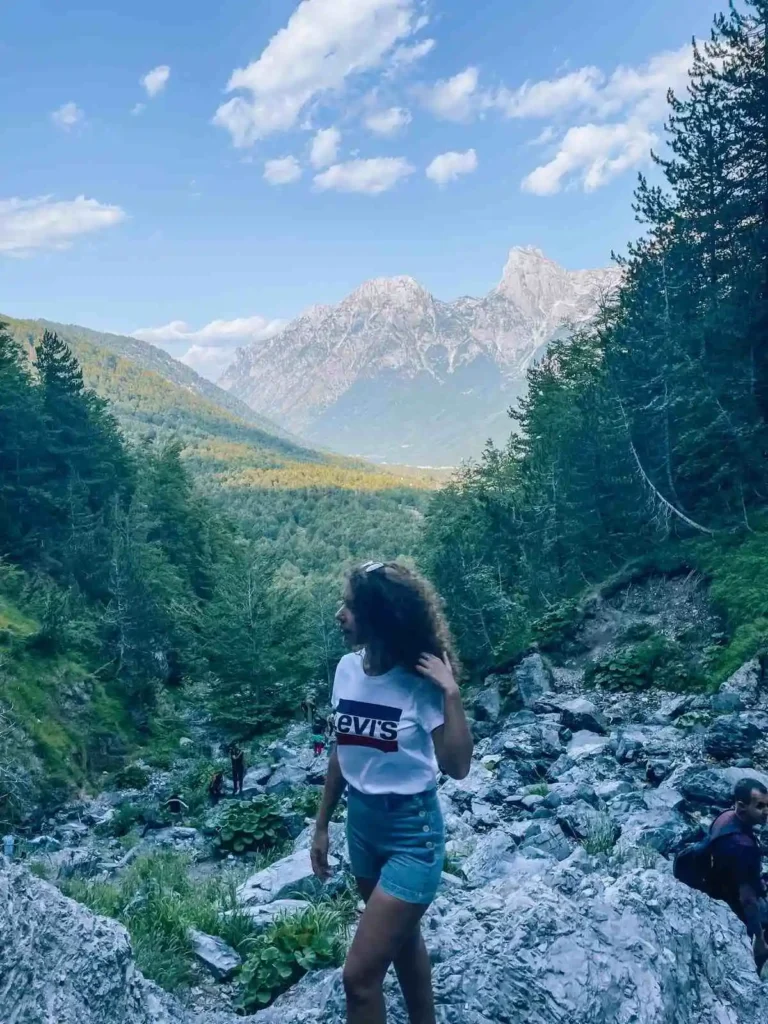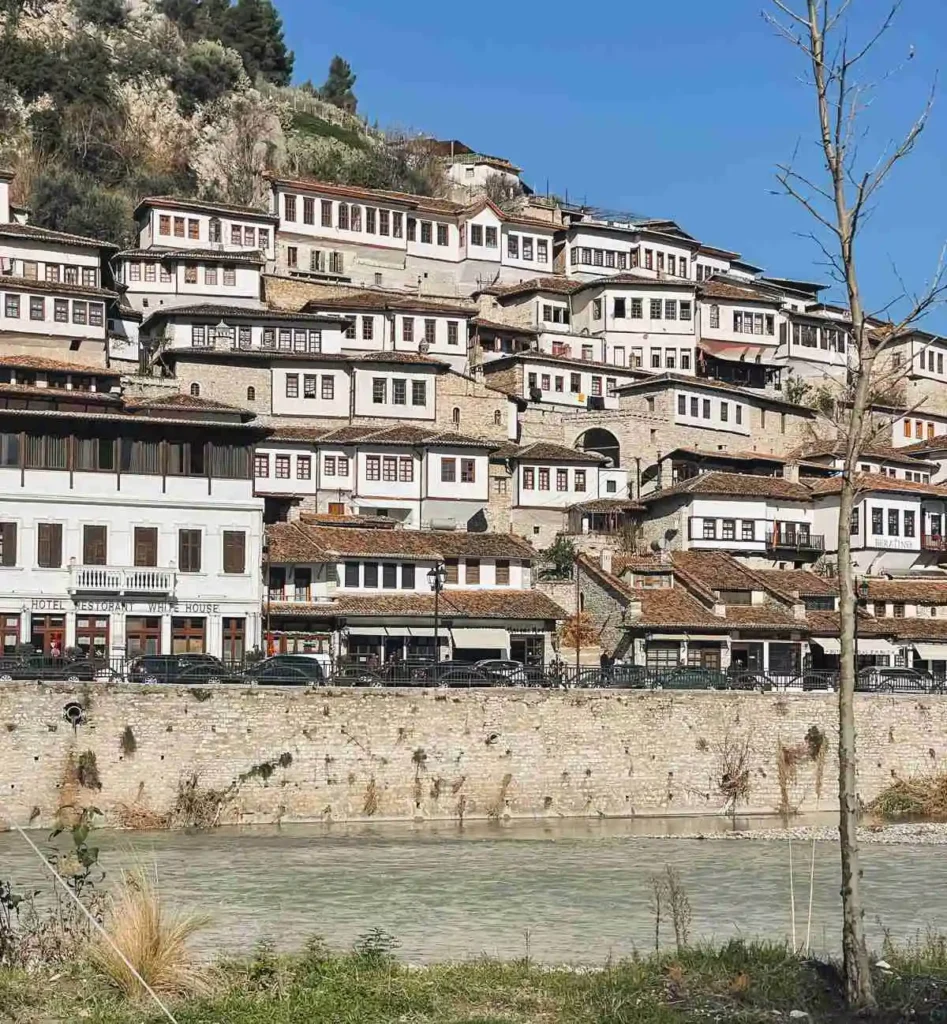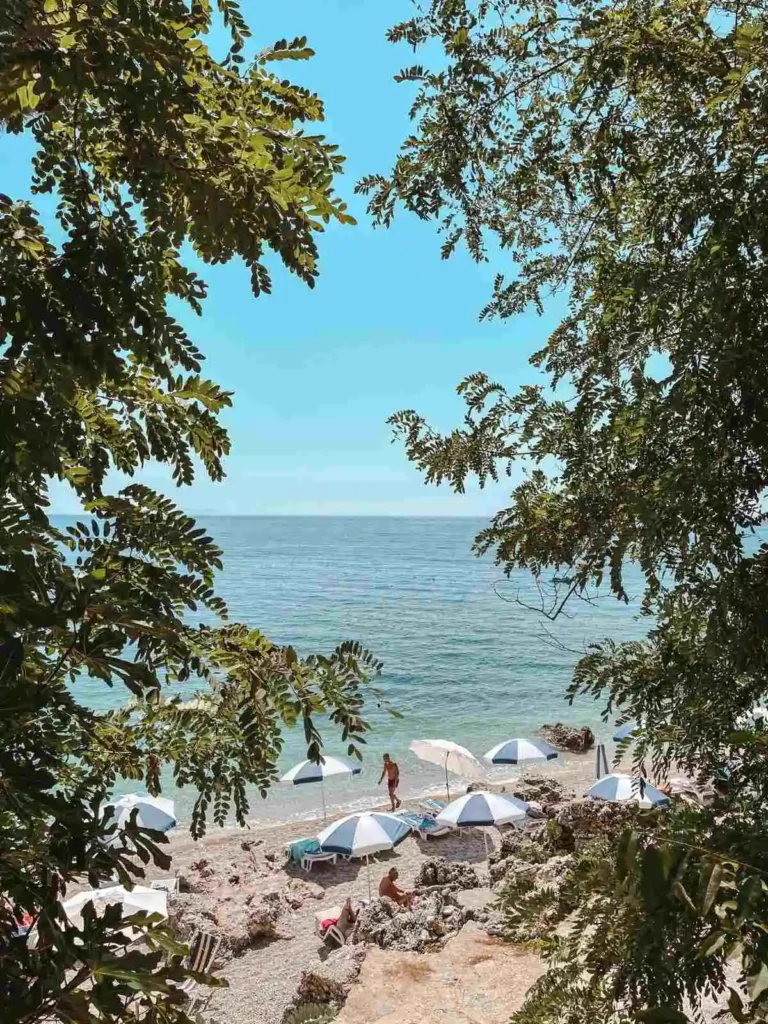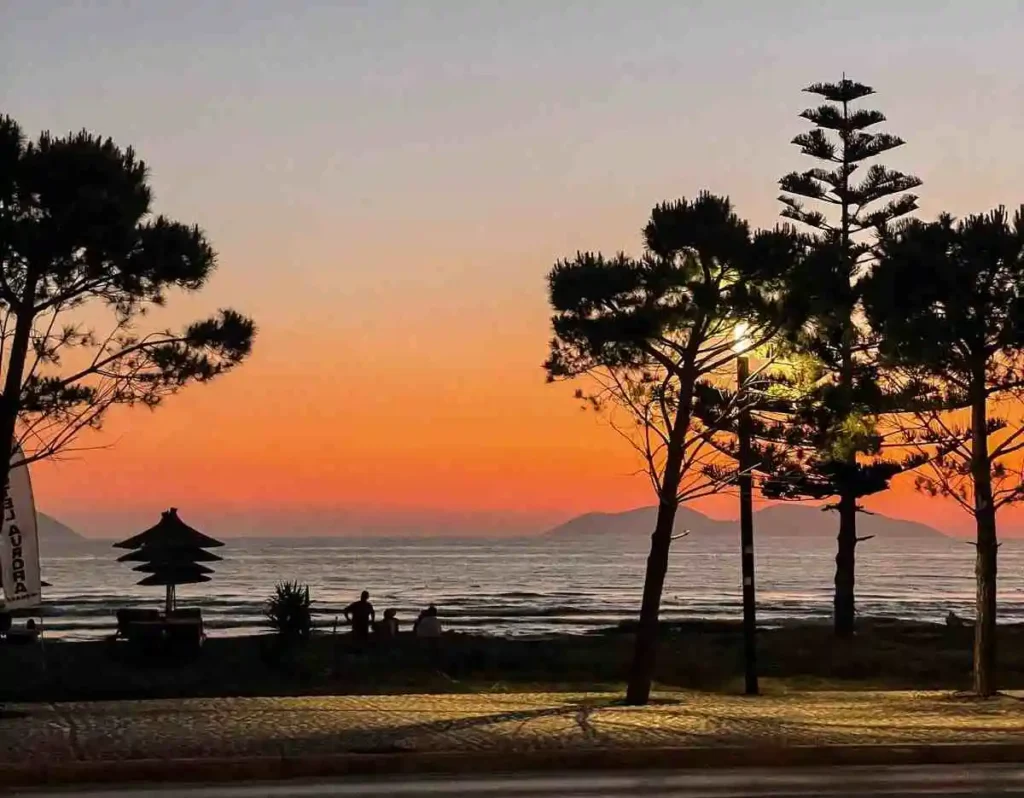Albania wasn’t just on my radar; it’s my home. And it still amazes me how many travelers have no idea what they’re missing.
From our rugged mountains and ancient hilltop towns to the crystal-clear beaches of the Ionian coast, Albania is a country of contrasts and surprises. We’ve got slow mornings with strong coffee, history that spans empires, and some of the kindest people you’ll ever meet (biased? Maybe. True? Absolutely.)
Whether you’re visiting for the first time or finally exploring the country your Albanian friends keep raving about, this guide covers everything you need to plan an unforgettable trip in 2025, what to see, where to go, when to visit, how to get around, and the little details no one tells you.
Let’s make sure you don’t miss a thing.
1. Is Albania Worth Visiting in 2025?
Short answer? Absolutely.
There’s a reason Albania is quickly climbing the list of must-visit destinations in Europe, and honestly, it’s about time. With a stunning coastline, dramatic mountain ranges, welcoming locals, and prices that haven’t caught up to the rest of Europe (yet), Albania is one of the best-kept travel secrets.
Still wondering why visit Albania in 2025? It’s everything people love about the Balkans, but with fewer crowds. You can enjoy beach towns without the tourist rush, hike through untouched national parks, or explore UNESCO towns without elbowing your way through selfie sticks.
It’s a perfect fit for all types of travelers:
– Digital nomads looking for an affordable base with fast Wi-Fi
– Budget travelers who still want amazing food and views
– Adventurers chasing off-the-beaten-path experiences
And yes, if you just want to sit by the sea with a coffee that still costs €1, Albania’s got you covered.
2. Best Time to Visit Albania
You can visit Albania year-round, but the best time to go really depends on what kind of experience you’re looking for: beach days, hiking, sightseeing, or just avoiding the crowds.
Here’s a breakdown of each season to help you choose the best time to visit Albania:
Spring (March to May)
Spring is one of the most beautiful and underrated times to visit Albania. Wildflowers are blooming, the landscapes are lush and green, and the temperatures range from 15°C to 30°C (59°F to 86°F) — ideal for both sightseeing and early beach days.
Tourist crowds haven’t arrived yet, so popular destinations like Berat, Gjirokastër, or even Saranda feel calm and uncrowded. Prices are moderate, making it a great time for budget-conscious travelers who still want nice weather.
Best for: mild weather, nature lovers, fewer crowds, early beach time
Summer (June to August)
Summer is the peak travel season in Albania, especially along the coast. Expect sunshine, packed beaches, and a lively atmosphere in places like Ksamil, Dhermi, and Himarë. But with the increase in popularity, you’ll also see a spike in prices and crowded accommodations.
Temperatures range from 30°C to even 40°C (86°F–104°F), especially with recent global warming trends. If you plan to visit during the summer, early June is the sweet spot, before the school holidays start and everything gets booked up. Try to avoid August if you’re not a fan of heat or crowds, as it’s the hottest and busiest month.
Best for: beach lovers, nightlife, festivals, coastal stays
Autumn (September to November)
Autumn is another top choice for visiting Albania, especially if you want warm weather without the summer chaos. The sea is still warm in September and early October, so you can enjoy the beaches without elbowing for space.
Temperatures remain mild, and rainfall is low. Plus, you’ll find more affordable accommodation and a relaxed vibe as the high season winds down. The fall colors in the mountains also make this a great time for hiking or road-tripping inland.
Best for: beach + hiking combo, mild weather, better deals
Winter (December to February)
Albania’s winters are relatively mild, especially in the south, with daytime temperatures around 11–15°C (52°F–59°F) and lows around 0–5°C (32°F–41°F) at night. While it’s not a traditional winter destination, the Albanian Alps do get snow, making them a quiet option for winter hikes or cozy escapes.
Most coastal towns are quiet during this season, and some businesses may close, but if you’re looking to avoid crowds completely and get a unique off-season experience, winter might surprise you.
Best for: off-the-beaten-path travel, snow in the mountains, low prices
So, When Is the Best Time to Visit Albania?
For most travelers, the best time to visit Albania is during spring and autumn, when the weather is pleasant, prices are lower, and the crowds are minimal. More specifically, the best months to visit Albania are:
April, May, September, and October.
You’ll get the best of both worlds: comfortable temperatures, great scenery, and plenty of time to explore, without the summer surge and with affordable prices.
My favourite time to visit Ksamil beach is in Early September.

3. Cost of Travel in Albania
Let’s be honest: prices in Albania are rising as the country becomes more popular. But compared to most of Europe (especially the neighbors like Greece, Italy, or Croatia), Albania is still very budget-friendly.
Here’s a general idea of what you can expect to spend:
Daily Travel Budget in Albania (2025)
- Budget travelers: You can comfortably get by on €40–€60 per day, especially if you’re staying in hostels, eating local food, and taking buses.
- Mid-range travelers: Expect to spend around €90–€120 per day. This includes boutique hotels, rental cars, meals out, and occasional tours.
- Luxury travelers: There’s no upper limit here — but you don’t need to spend thousands. A 5-star hotel in Tirana or the Albanian Riviera can cost around €200–€350 per night, often with incredible sea views and modern amenities.
Accommodation Costs
- Budget hostels & guesthouses: from €25–€40 per night
- Mid-range hotels & Airbnbs: around €50–€100 per night
- Luxury stays: from €150–€350+ per night, depending on location and season
Pro tip: You’ll find the best value in the shoulder seasons (April, May and September, October), when prices drop but the weather is still great.
Transport Costs
Public transportation in Albania isn’t the most efficient, but it’s cheap.
- Intercity buses: cost anywhere from €2–€10, depending on distance
- City buses in Tirana: a one-way ticket is just €0.40
- Taxis: Start at around €2.50 and go up from there
- Car rentals: Usually €20–€50/day, plus gas.
While buses work well for budget travelers, many visitors opt to rent a car to explore Albania more freely, especially if you’re heading to the mountains or remote beaches.
Overall, traveling in Albania in 2025 is still affordable, especially for what you get in return. Whether you’re backpacking through the Balkans or treating yourself to a luxury beach stay, Albania offers excellent value for money at every level.
For example, a weekend for two in Himara (1 night stay, 2 beach days) costs me 200euros all inclusive.
4. Entry Requirements and Visas
If you’re planning a trip to Albania, the good news is that for many travelers, entry is surprisingly easy. Citizens of the EU, Schengen Zone, UK, US, Canada, and many other countries can visit visa-free for up to 90 days within a 180-day period. Albania also allows entry without a visa if you hold a valid multiple-entry visa or residence permit from Schengen countries, the US, or the UK — which makes it even more accessible for digital nomads and long-term travelers bouncing around Europe.
If you’re planning to stay longer than 90 days, you’ll likely need to apply for a Type D visa or residence permit, which can usually be started after arrival. For those who do need a visa, Albania offers both e-Visas and visa-on-arrival options, depending on your nationality. Just make sure your passport is valid for at least 3 months beyond your departure date and has a few blank pages. You may also be asked to show proof of onward travel, sufficient funds, and the purpose of your visit — especially if you’re applying for a long-stay visa.
Border crossings in Albania are generally smooth, with over a dozen official entry points by land, sea, and air. Most are straightforward, but smaller land borders can feel a bit slower or less organized. Border officers may ask basic questions like how long you’re staying or where you’re headed, and if you’re arriving by car, you’ll need to show your registration, insurance, and driver’s license. Avoid crossing unofficial “green borders,” especially if you’re hiking remote areas like the Peaks of the Balkans — these often require special permits. Wait times can increase during summer and holidays, so be prepared with a little patience and a fully charged phone.
Finally, if you’re considering staying beyond the visa-free limit, check if your country has any bilateral agreements with Albania. For example, US citizens can stay up to one year without a long-stay visa, though this sometimes requires exiting and re-entering to reset the clock. Rules can and do change, so it’s always best to confirm details through the Albanian Ministry of Foreign Affairs or your local embassy before your trip.

5. Where to Go in Albania: Top Destinations
Albania might look small on a map, but it packs in more variety than you’d expect, from buzzy cities and UNESCO hill towns to wild mountain passes and beaches that feel like they belong in the Caribbean. Whether you’re here for a quick getaway or planning a full Balkan road trip, here are the top places to visit in Albania that absolutely deserve a spot on your itinerary.
Tirana – Albania’s Colorful, Chaotic Capital
Tirana is the energy center of modern Albania. Once gray and closed off, it’s now bursting with life, color, and cool cafés on every corner. You can stroll Skanderbeg Square, explore the Bunk’Art museums to get a glimpse of Albania’s communist past, or just people-watch with a macchiato in hand. And don’t miss Blloku, the former party elite’s district turned into a hipster nightlife haven.
Expect graffiti art, rooftop bars, and the weird-but-wonderful Pyramid of Tirana.
Berat – The City of a Thousand Windows (UNESCO)
Berat is one of the most postcard-perfect places in Albania — and for good reason. This UNESCO World Heritage Site is known for its hillside of white Ottoman houses, all stacked up with rows of identical windows (hence the nickname). Explore the charming Mangalem and Gorica quarters, wander cobbled lanes, cross the old stone bridge, and hike up to Berat Castle, still home to local families today.
It’s dreamy at sunset, so stay the night if you can.
Gjirokastër – The Stone City (UNESCO)
If Berat is sweet and serene, Gjirokastër is moody and dramatic, in the best way. Another UNESCO gem, this town is all cobblestones and stone rooftops with a deep sense of history. The massive Gjirokastër Castle looms over the town and offers views across the Drino Valley. You’ll also find quirky museums, traditional houses turned guesthouses, and a lively old bazaar that’s perfect for picking up souvenirs.
Bonus: It’s the hometown of Albania’s most famous writer, Ismail Kadare.
The Albanian Riviera – Beaches, Views & Laid-back Vibes
Dreaming of crystal-clear water and quiet beach towns? Welcome to the Albanian Riviera, the southern coast that runs from Vlora to Saranda. This stretch is filled with pebbly coves, turquoise water, and chill summer vibes.
Vlora: Where the Adriatic and Ionian Seas meet. Good for nightlife and long seaside walks.
Himara: Smaller, slower, and more local, with some of the best hidden beaches.
Saranda: The busiest hub, great for day trips to Butrint National Park and the Ksamil Islands, where the water looks like a Photoshop filter (but real). Let’s say there you will explore the true Albania…
Theth & Valbona – Albania’s Hiking Heaven
Want to escape the beach and head into the wild? Northern Albania has you covered. Theth and Valbona, tucked deep in the Accursed Mountains (yes, that’s the real name), are an absolute dream for hikers and nature lovers. The Theth to Valbona trail is one of the most iconic hikes in the Balkans, full of waterfalls, panoramic passes, and traditional stone guesthouses where you’ll be welcomed like family.
It’s rugged, remote, and completely magical.
Where Should You Go in Albania?
If it’s your first visit, try to mix city, beach, and mountains. Tirana gives you a taste of modern Albania, Berat and Gjirokastër show off the country’s cultural depth, the Riviera handles the beach days, and Theth or Valbona will blow your mind if you love the outdoors.
6. How to Get Around Albania
Albania’s public transport system mainly consists of furgons (shared minibuses) and local buses. They’re by far the cheapest way to travel, but not always the easiest. Most furgons don’t have fixed schedules, online booking isn’t really a thing, and routes between smaller towns can be inconsistent. Delays are common, and you’ll often need to ask locals or hotel staff for help figuring out departure times or pick-up spots.
Tip: If you’re not in a rush and want a local experience, furgons can be fun, just don’t expect Google Maps to help you out.
One time, I needed to travel from Tirana to Laç on the very last scheduled furgon of the day. I showed up at the departure point on time, only to find it had already left. In Albania, furgons don’t always stick to their posted schedule; once they’re full, they simply leave, and there’s no replacement or “next one” coming. If you want to explore Albania by furgons, it was a good reminder to arrive early and never rely on the last bus of the day.
Car Rentals: The Best Way to Explore
If you want flexibility and plan to explore beaches, mountains, or rural areas, renting a car is hands-down the best option. While Albania’s road conditions aren’t quite up to European standards, think potholes, missing signage, and the occasional herd of goats, most main roads are paved and totally manageable with a little patience.
Driving gives you freedom to explore at your own pace, especially in the Albanian Alps or along the Riviera, where public transport options are limited or nonexistent.
Note: Petrol in Albania is one of the most expensive in Europe, so factor that into your travel budget. You may also come across tolls or parking fees in bigger cities.
What About Taxis?
Taxis are available in major cities, but they’re best for short distances only. Always make sure the driver is using the meter (taximeter), and if they refuse, it’s better to find another cab or use a rideshare alternative if available. For longer trips, it’s usually more cost-effective to rent a car than take a taxi.
Should You Rent a Car in Albania?
If you’re planning to explore beyond Tirana, yes, rent the car. Public transport works for budget travelers, but it can be limiting and time-consuming. A rental gives you freedom, access to hidden spots, and way less waiting around at dusty bus stops.

7. What to Eat & Drink in Albania
Albanian food? Criminally underrated.
It’s the kind of cuisine that makes you wonder how it’s not more famous — a delicious mash-up of Mediterranean freshness, Balkan comfort, and Ottoman richness, all served with a big scoop of hospitality. While you’ll find your usual pizza and burgers in cities, if you skip the local dishes, you’re seriously missing out.
Let’s talk about the foods that will have you planning your next trip before you’ve even finished your plate:
Byrek
Flaky, golden, and dangerously addictive. Byrek is a savory pastry filled with cheese, spinach, meat, or even pumpkin. It’s street food perfection, and yes, Albanians eat it for breakfast, lunch, snacks… basically whenever. You’ll see locals grabbing it on the go, and for good reason: it’s cheap, filling, and hits every time.
Tavë Kosi
The unofficial national dish, and totally comfort food status. It’s a warm, baked combo of lamb (or chicken), yogurt, and rice that turns into this creamy, tangy casserole you didn’t know you needed in your life. The kind of meal that makes you feel at home, even if you’re thousands of miles away.
Fërgesë
Think of this one as Albania’s answer to cheesy stew. Peppers, tomatoes, cottage cheese (djathë i bardhë), and olive oil all baked into one bubbling dish of goodness. Scoop it up with bread and thank me later.
Fresh Seafood
Along the coast? You’re in seafood heaven. Places like Saranda, Himara, and Vlora serve up grilled fish, octopus, and mussels so fresh they probably met the sea an hour ago. And unlike the Med’s glitzy hotspots, here you won’t pay €40 for a single shrimp.
Baklava & Trilece
Albania does dessert very well. The baklava is syrupy, nutty, and dangerously sweet. Trilece (a sponge cake soaked in three types of milk) is lighter but just as addictive. Order both. No regrets.
What to Drink (Because You’ll Definitely Be Offered Something) Rakia
Strong, homemade, and offered with love. This fruit brandy is an Albanian tradition, usually made from grapes or plums. Locals will pour it for you as a welcome, a farewell, or just because. Sip very slowly.
Albanian Wine
Don’t sleep on the local wines. The reds from Berat and Shkodra are rich and earthy, and most restaurants serve local bottles at budget-friendly prices.
Çaj Mali (Mountain Tea)
No caffeine, no problem. This herbal tea made from wild sage is soothing and fragrant a staple in every home and mountain guesthouse. Hot in winter, chilled in summer, always comforting.
Tips for Vegetarians & Vegans
Albanian food leans meaty, especially in traditional restaurants. But plant-based travelers won’t go hungry:
Look for byrek with spinach or pumpkin
Try fërgesë made without meat
Load up on fresh tomato-cucumber salads, olives, grilled veggies, and baskets of warm bread
In bigger cities like Tirana, vegetarian cafés and global menus are becoming the norm. Just note: dairy sneaks into a lot of dishes, so if you’re vegan, remember these magic words:
- “Pa djathë” = without cheese
- “Pa kos” = without yogurt
Want bonus points with locals? Compliment their food. Food is love here, and sharing it with you means you’re already a little bit Albanian.
9. Is Albania Safe to Visit?
Short answer? Yes, Albania is very safe to visit, even for solo travelers. I’ve explored the country from the beaches of the Riviera to the mountain villages up north, and I even lived alone in Tirana for six years. In all that time, I never had a single safety issue. Albanians are incredibly hospitable, it’s part of the culture, and crime against tourists is rare.
But like anywhere else, it’s smart to stay aware and use common sense. Here’s what you should know before you go:
General Safety
Walking around Tirana, coastal towns like Himara and Saranda, or even small mountain villages, is safe during the day and night. Just like in any city, avoid dark or isolated areas late at night, especially if you’re alone. But overall, Albania feels relaxed and secure, even compared to more well-known European destinations.
Scams & Tourist Traps
Petty scams are not common here; Albania isn’t overrun with tourist traps like some other places in Europe. That said, it’s still a good idea to double-check taxi fares, especially outside the airport. In Tirana, I recommend using apps like Merr Taxi or Speed Taxi to avoid any confusion. Always review your restaurant bill before paying (just in case).
Solo Travel
Albania is an excellent destination for solo travelers, including solo female travelers. People are curious and friendly, and it’s totally normal for locals to offer help or strike up a conversation. It’s rarely intrusive, just part of the culture.
I’ve walked home alone at night, taken local buses solo, and explored remote areas — and always felt completely safe.
Nightlife Safety
Planning to enjoy Albania’s nightlife? Go for it, just take the same precautions you would anywhere. Watch your drink, avoid walking home alone late at night, and don’t overdo it with alcohol if you’re not with trusted people. Cities like Tirana have a vibrant club scene, especially in Blloku.
Local Laws & Travel Etiquette
Driving
Roads have improved massively over the past decade, but driving can still be chaotic. Expect fast drivers, spontaneous lane changes, and the occasional donkey or goat crossing the road. Always carry your license, rental paperwork, and insurance. If the police stop you, don’t panic, it’s often a routine check. Stay calm, be polite, and show your documents.
Drugs
Albania has strict drug laws, and even small amounts of illegal substances can get you fined or arrested. Just don’t go there.
Cultural Etiquette
Albanians are warm, direct, and incredibly proud of their hospitality. A simple “Faleminderit” (thank you) will go a long way. Don’t be surprised if someone invites you for coffee or helps you out without expecting anything in return — it’s part of the charm.
Bottom Line: Is Albania Safe?
Yes, Albania is very safe for tourists, couples, and solo travelers alike. Use basic travel common sense: avoid deserted streets at night, keep an eye on your belongings, drink responsibly, and be aware of your surroundings. Do that, and not only will you feel safe, you’ll likely feel welcomed and looked after.
Real talk: Albania is one of the few places where I’ve felt like the locals genuinely wanted me to enjoy their country, and that makes all the difference.

10. things to know before visiting Albania
Before you hop on a plane (or start that road trip to discover the true Albania), here are a few quick things to know that will make your trip to Albania smoother — and maybe even save you a few euros along the way:
Currency
Albania uses the Lek (ALL), and it’s a cash-friendly country.
While euros are sometimes accepted in tourist areas, especially along the coast, it’s best to pay in Lek for better rates and fewer headaches. ATMs are widely available in cities and bigger towns.
Pro tip: Don’t bring coins in euros, only bills are accepted, and you usually won’t get change back.
Language
The official language is Albanian (Shqip), and while younger people in cities often speak English, don’t expect it everywhere, especially in rural areas.
Learning a few words like “Faleminderit” (thank you) or “Përshëndetje” (hello) goes a long way and earns you big smiles from locals.
SIM Cards & Mobile Data
Getting connected is easy, you’ll find tourist SIM cards at the airport and local kiosks.
The two main providers are Vodafone and One, and both offer solid coverage with affordable data plans. You can get unlimited data for a week or two at very low prices, perfect if you’re navigating by Google Maps or posting those Riviera beach photos in real-time.
Tipping Culture
Yes, tipping is appreciated in Albania.
It’s not mandatory, but rounding up the bill or leaving 10% at restaurants, cafés, and with taxi drivers is common and considered polite. At more upscale places, 10–15% is standard.
Final Thoughts: Why Albania Should Be Your 2025 Travel Pick
Albania isn’t just a hidden gem, it’s a country that surprises you in the best ways. Whether it’s your first visit or your tenth, you’ll always find something new: a secret beach cove, a cozy mountain guesthouse, a village festival, or just a local inviting you for a strong coffee and a good story.
If you’re craving a trip that’s rich in history, full of natural beauty, and still affordable (but probably not for long), Albania in 2025 is the place to be.
So whether you’re planning a digital nomad stint, a Balkan backpacking loop, or a sun-soaked beach escape, I hope this guide gave you everything you need to feel confident and excited for your trip.
See you in the mountains… or on the beach.
